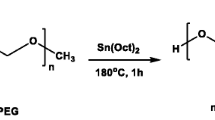Abstract
Biodegradability of poly(γ-benzyl L-glutamate)/poly(ethylene oxide)/poly(γ-benzyl L-glutamate) block copolymer (GEG) having different content of poly(ethylene oxide) (PEO) were examined using magnetite as a tracer in mice. GEG microspheres containing magnetite were injected into mice through tail vein. Biodegradability and tissue distribution of microspheres were examined by analyzing the amount of magnetite in the microspheres recollected from mice organs after specific time interval. The results showed that GEG microsphere of high content of PEO was degraded more rapidly than those of low content of PEO in the mice organs.
Similar content being viewed by others
References Cited
Burger, J. J., Tomlinson, E., Mulder, E. M. A. and McVie, J. G., Albumin microspheres for intra-arterial tumour targeting. I. Pharmaceutical aspects.Int. J. Pharm., 23, 333–344 (1985).
Cho, C. S. and Kim, S. U.In vitro degradation of biodegradable poly(γ-benzyl L-glutamate)/poly(ethylene glycol) block copolymers.J. Contr. Res., 7, 283–286 (1988).
Cho, C. S., Kim, S. W. and Komoto, T. Synthesis and structural study on an ABA block copolymer consisting of poly(γ-benzyl L-glutamate) as the A block and poly(ehtylene oxide) as the B block.Makromol. Chem., 191, 981–991 (1990).
Cho, C. S., Park, J. W., Kwon, J. K., Jo, B. W., Lee, K. C., Kim, K. Y. and Sung, Y. K. Release of cytarabine from biodegradable poly(γ-benzyl L-glutamate) /poly(ethylene oxide)/poly(γ-benzyl L-glutamate) block copolymer microsphere.Polymer (Korea), 15, 27–33 (1991).
Cho, C. S., Kwon, J. K., Jo, B. W., Lee, K. C. and Sung, Y. K., Release of cytarabine from poly(ε-carbobenzoyl L-lysine)/poly(ethylene oxide)/poly(ε-carbobenzoxy L-lysine) block copolymer microsphere.J. Kor. Pharm. Sci. 22, 323–326 (1992).
Iwata, M. and McGinity, W. Dissolution, stability, and morphological properties of conventional and multiphase poly(DL-lactic-co-glycolic acid) microspheres containing water-soluble compounds.Pharm. Res., 10, 1219–1227 (1993).
Juni, K., Ogata, J., Matsui, N., Kubota, M. and Nakano, M., Modification of the release rate of aclarubicin from polyatic acid microspheres by using additives.Chem. Pharm. Bull, 33, 1734–1738 (1985).
Kim, Y. H., Cho, C. S., Sung, Y. K., Chung, B. H. and Lee, K. C. Poly(γ-benzyl L-glutamate)/poly(ethylene oxide)-lactoselactone block copolymers and their microspheres.J. Kor. Pharm. Sci., 22, 237–240 (1992).
Kojima, T., Nakano, M., Juni, K., Inoue, S. and Yoshida, Y., Preparation and evaluationin vitro andin vivo of polycarbonate microspheres containing dibucaine.Chem. Pharm. Bull., 33, 5119–5125 (1985).
Lee, K. C. and Koh, I. B. Intravascular tumour targeting of aclarulbicin-loaded gelatin microspheres. Preparation, biocompatibility and biodegradability.Arch. Pharm. Res., 10, 42–49 (1987).
Lee, K. C., Koh, I. B., Kim, W. B. and Lee, Y. J., Size and morphological morphological analysis of albumin microspheres in the lungs and liver of mice.Int. J. Pharm., 44, 49–55 (1988a).
Lee, K. C. The use of magnetite for estimation of microspheres in mice.Int. J. Pharm., 47, 265–267 (1988b).
Oh, I. J., Oh, J. Y. and Lee, K. C. Assessment of biodegradability of polymeric microspheresin vivo: Poly (DL-lactic acid), poly(L-lactic acid and poly(DL-lactide-co-glycolide) microspheres.Arch. Pharm. Res., 16, 312–317 (1993).
Paventto, F., Conti, B., Genta, I. and Giunchedi, P., Solvent evaporation, solvent extraction and spray drying for polyactide microsphere preparation.Int. J. Pharm., 84, 151–159 (1992).
Sanders, L. M., McRae, G. I., Vitale, K. M. and Kell, B. A., Controlled delivery of an LHRH analogue from biodegradable injectable microspheres In Anderson, J. and Kim, S. W. (Eds.),Advances in Drug Delivery Systems, Elsevier, Amsterdam, 1986, pp. 187–195.
Spenlehauer, G., Vert, M., Benoit, J. P. and Boddaet, A.,In vitro andin vivo degradation of poly(D,L lactide/glycolide) type microspheres made by solvent evaporation method.Biomaterials, 10, 557–563 (1989).
Wang, H. T., Palmer, H., Linhardt, R. J., Flanagan, D. R. and Schmitt, E. Degradation of poly(ester) microspheres.Biomaterials, 11, 680–685 (1990).
Yoshioka, T., Hashida, M., Muranishi, S. and Sezaki, H., Specific delivery of Mitomycin C to the liver, spleen and lung: Nano- and microspherical-carriers of gelatin.Int. J. Pharm., 81, 131–141 (1981).
Author information
Authors and Affiliations
Rights and permissions
About this article
Cite this article
Oh, I.J., Oh, J.Y., Cho, C.S. et al. Biodegradability of poly(γ-benzyl L-glutamate)/poly(ethylene oxide) /poly(γ-benzyl L-glutamate) block copolymer in mice. Arch. Pharm. Res. 18, 8–11 (1995). https://doi.org/10.1007/BF02976499
Received:
Issue Date:
DOI: https://doi.org/10.1007/BF02976499




